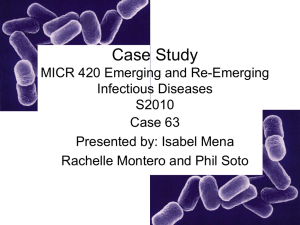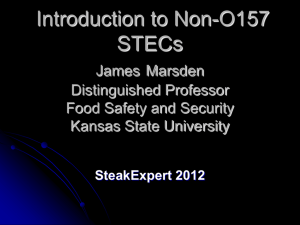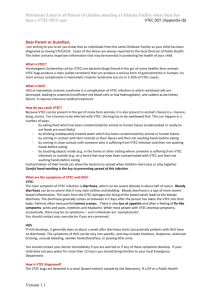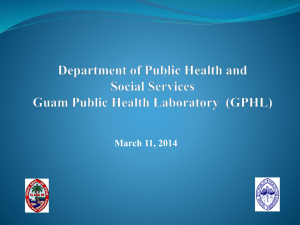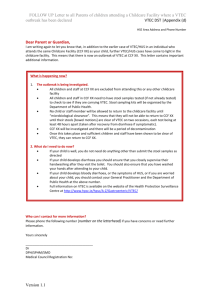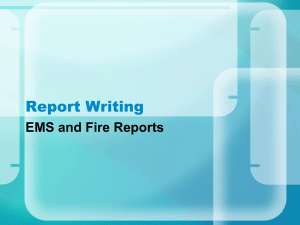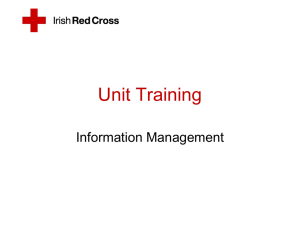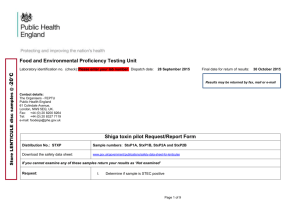Irish VTEC Network 2012 Conference Presentation (size 726.5 KB)
advertisement
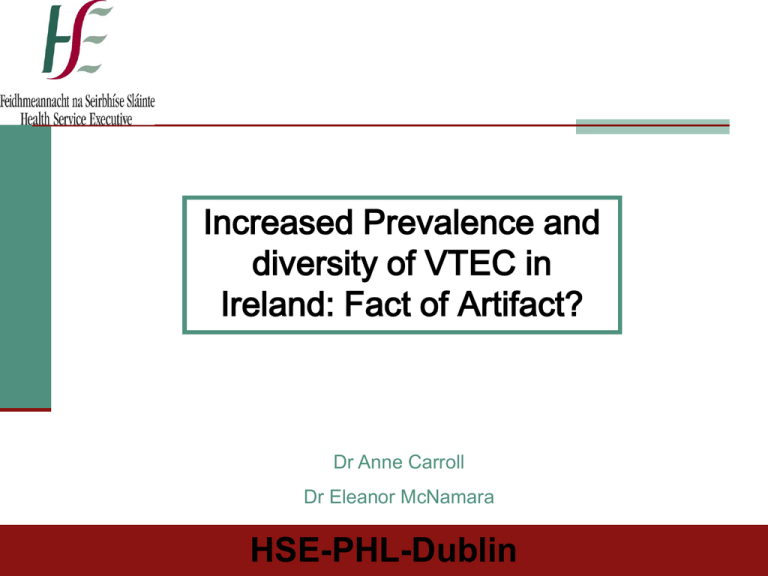
Increased Prevalence and diversity of VTEC in Ireland: Fact of Artifact? Dr Anne Carroll Dr Eleanor McNamara HSE-PHL-Dublin PHL Scope Official testing laboratory, Food and water (S.I. 85 of 1998 and S.I. 117 of 2010) . Accredited ISO 17025 National VTEC diagnostic and typing service (Clinical, foods water environmental) Clinical diagnostic general microbiology service, hospital/GP HSE-PHL-Dublin VTEC Reference Service National VTEC Service Stools, Food, Water. Isolate Confirmation Accredited PCR >22,000 tests PFGE HSE-PHL-Dublin VTEC incidence Year 2002 2003 2004 2005 2006 2007 2008 2009 2010 2011 Numbers of Incidence/100000 VTEC cases 1.7 68 2.1 82 1.4 51 3.0 123 3.7 159 3.9 115 5.3 223 5.7 240 4.8 202 5.9 270 7 6 5 4 Total O157 non-O 3 2 1 0 Year 2002 Year 2003 Year 2004 Year 2005 Year 2006 Year 2007 Incidence/100000 HSE-PHL-Dublin Year 2008 Year 2009 Year 2010 Year 2011 VTEC incidence Year 2002 2003 2004 2005 2006 2007 2008 2009 2010 2011 Year 2004 2005 2006 2007 2008 2009 2010 2011 Numbers of Incidence/100000 VTEC cases 1.7 68 2.1 82 1.4 51 3.0 123 3.7 159 3.9 115 5.3 223 5.7 240 4.8 202 5.9 270 7 6 5 4 Total O157 non-O 3 2 No. Samples % positive 1 Analysed* cases 599 8.5 0 996 12.3 1360 11.7 1468 10.8 2403 9.3 3550 6.8 3283 6.2 4943 5.5 Year 2002 Year 2003 Year 2004 Year 2005 Year 2006 Year 2007 Incidence/100000 HSE-PHL-Dublin Year 2008 Year 2009 Year 2010 Year 2011 VTEC Serogroups 100% 90% 80% 70% 60% Other O26 O157 50% 40% 30% 20% 10% 0% year 2004 year 2005 year 2006 year 2007 year 2008 year 2009 HSE-PHL-Dublin Year 2010 Year 2011 2011 VTEC serogroups Serogroup O157 O26 O111 O128ad O145 O146 O150 O185 O5 O76 O44 O91 O130 O149 O166 O6 O8 Ungroupable vtx1(%) 0(0) 29(58) vtx2(%) 153(72.5) 1(2) 0 0 0 3(100) 0 0 0 1(100) 6(75) 1(100) 0 0 3(100) 0 2(100) 0 0 2(25) 0 0 1(100) 0 0 1(100) 1(100) 0 4(100) 0 3(25) vtx1+vtx2(%) 58(27.5) 20(40) 0 1(100) 0 1(100) 4(33.4) 0 0 0 1(100) 0 0 1(100) 0 1 5(41.6) 0 0 0 0 Total No.(%) 211 (100) 50 (100) 1 (100) 1 (100) 3 (100) 3 (100) 2 (100) 1 (100) 8 (100) 1 (100) 1 (100) 1 (100) 1 (100) 1 (100) 1 (100) 4 (100) 1 (100) 12 (100) HSE-PHL-Dublin 2011: 17 serogroups 15 clinical +2 food 2002-2011 33 serogroups + 2011 HPSC VTEC subgroup HPSC Ref lab 5 labs Public health Consensus + recommend standardised methods for VTEC HSE-PHL-Dublin Risk Risk USA ROI Scotland E&W Nordic Bloody diarrhoea HUS Isolates OB contacts symptomatic (O157) ? (O157) (O157) (optimal) Community acq Diarrhoea Food handler Abdominal Cramps Contact with ruminants Consumption raw animal products or raw fruits/veg Contact with animal products e.g. manure Hospitalised HSE-PHL-Dublin Lab Methods US “all stools submitted for routine testing from patients be simultaneously cultured for O157 and tested with an assay that detects Shiga toxins to detect non-O157 STEC” “Specimens or enrichment broths in which Shiga toxin or STEC are detected but from which O157 STEC are not recovered should be forwarded as soon as possible to a state or local public health laboratory”. HSE-PHL-Dublin Lab Methods ROI Method Risk 1 2 3 4 5 6 CT-SMAC /Chrom High Agglutination O157 High Enrichment High Low Low (outbreakO157) (outbreakO157) (O157, O26, O111) Low IMS High Low Non-O157 agglutination High O157 gene detection High VT gene detection High Low Low Low HSE-PHL-Dublin Lab 1 Method Risk 1 CT-SMAC /Chrom High Agglutination O157 High Enrichment High Low Low Low IMS High Low Non-O157 agglutination High O157 gene detection High VT gene detection High Low Low Low HSE-PHL-Dublin Lab 1 Method Risk 1 CT-SMAC /Chrom High Agglutination O157 High Enrichment High Low Low Low IMS High Low Non-O157 agglutination High O157 gene detection High VT gene detection High Low Low Low HSE-PHL-Dublin 2012 Jan-Apr 2012 2011 2010 2009 14 0 0 1 (3xO103, 1xO111, 5x ungp, 1x O145, 4xO26) Whole year (1x O105 ac) 4 4 12 (1x ungp, 1x O150, 1x O91, 1x O26) All picked up by ref lab as part of O157 OB screen (1xO121, 3x O26) (1x O105 ac, 4x ungp, 1x O145, 1x O103, 1x O178, 4x O26) 7 picked up by ref lab as part of OB screen Pre 2012 samples referred to ref lab based on risk and not lab findings (stools). HSE-PHL-Dublin Lab 7 Method Risk 7 CT-SMAC /Chrom High Agglutination O157 High Enrichment High Low Low Low IMS High Low Non-O157 agglutination High O157 gene detection High VT gene detection High Low Low Low HSE-PHL-Dublin Lab 7 Method Risk 7 CT-SMAC /Chrom High Agglutination O157 High Enrichment High Low Low STEC CHROMagar Low IMS High Low Non-O157 agglutination High O157 gene detection High VT gene detection High Low Low Low HSE-PHL-Dublin Jan-Apr Whole year 2012 2011 2010 2009 10 1 0 2 (2x O145, 7x O26, 1x ungp) (1xO26) (2xO26) 4 3 3 (3x O26, 1x O5) O5 picked up by ref lab as part of OB screen (1xungp, 2xO26) (3xO26) Pre 2012 samples referred to ref lab primarily based on lab findings and not risk (Isolates) HSE-PHL-Dublin Lab 2 Method Risk 2 CT-SMAC /Chrom High Low Agglutination O157 High Low Enrichment High No changes to methods Low IMS High Low Non-O157 agglutination High Low O157 gene detection High Low VT gene detection High Low HSE-PHL-Dublin Jan-Apr Whole year 2012 2011 2010 2009 14 12 2 4 (14x O26) (9xO26, 3xO146) (2xO26) (4xO26) 41 27 12 (28x O26, 1x O150, 1xO44, 2xO5, 1xO76, 3xO146, 5x ungp) (27xO26) (5xO26, 3xungp, 2x O121, 2x O132) samples referred to ref lab based on both lab findings and risk (stools and isolates) HSE-PHL-Dublin Issues PCR Direct from stool PCR pos culture negative issue Direct detection of vt1 or vt2 gene(s) (without strain isolation), probable or confirmed depending on clinical criteria (HPSC) HSE-PHL-Dublin Issues Ref lab Direct PCR, Enrichment/IMS PCR, colony confirmation. 1. 2. 3. Direct PCR pos and/or Enrichment/IMS PCR pos + colony confirmed Direct PCR pos + Enrichment/IMS PCR pos but can’t isolate colony Direct PCR pos + Enrichment/IMS PCR neg Do 2 +3 have the same PH implications? HSE-PHL-Dublin 2) Direct PCR pos + Enrichment/IMS PCR pos but can’t isolate colony Organism seems to be growing viable Shedding of viable organism possible PH risk Source of infection HSE-PHL-Dublin 3) Direct PCR pos + Enrichment/IMS PCR neg Organism not growing not viable Shedding of non viable organism not a PH risk May have been infection with organism subsequently dying source of infection May have been no infection but ingestion of non viable organism e.g. from treated water or processed food HSE-PHL-Dublin If Use PCR only result (2 or 3) may not be true result O26 vt2 PCR pos O26 vt2 O26 vt neg + other serogroup vt2 pos O26 vt2 + other serogroup vt2 pos HSE-PHL-Dublin Challenges Methods Risk Transport Facilities IT HSE-PHL-Dublin Summary VTEC in recent years Particularly in non-O157 VTEC Introduction of mandatory notification Increased awareness non-O157 VTEC Recent increases of non-O157 VTEC can be attributed to more targeted methods Challenges Clinical and lab findings need to be taken together Lab + PH need to communicate HSE-PHL-Dublin Thank You Thank you to dedicated PHL Staff HSE-PHL-Dublin VTEC Reference Service Outbreak Service Primary High Risk sample analysis Confirmation and Typing Medical advisory service OCT Data collation HSE-PHL-Dublin
